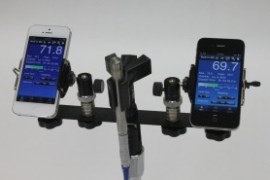
by Brianna Crandall — April 23, 2014—The National Institute for Occupational Safety and Health (NIOSH) recently released information on its Science Blog that can help facilities managers and others concerned with workplace noise control determine whether their smartphone applications (apps) are accurate enough to determine safe occupational noise levels.
As explained on the NIOSH Science Blog: So How Accurate Are These Smartphone Sound Measurement Apps? page, smartphone developers now offer many sound measurement apps using the devices’ built-in microphone (or through an external microphone for more sophisticated applications).
According to NIOSH, the use of these smartphone sound measurement apps can have a tremendous and far-reaching impact in the areas of noise research and noise control in the workplace as every smartphone can be potentially turned into a dosimeter or a sound level. However, in order for smartphone apps to gain acceptance in the occupational environment, the apps must meet certain minimal criteria for functionality, accuracy, and relevancy to the users in general and the worker in particular.
NIOSH noise researchers received numerous requests from stakeholders, safety professionals, and the public to address the accuracy of the many sound measurement applications available for smartphones and whether they can be relied upon to provide an accurate assessment of the ambient environment.
As a result of these enquiries, NIOSH conducted a pilot study to select and characterize the functionality and accuracy of these apps as an initial step in a broader effort to determine whether these apps can be relied on to conduct participatory noise-monitoring studies in the workplace. The resulting paper, Evaluation of Smartphone Sound Measurement Application, was published in the Journal of the Acoustical Society of America.
According to the article abstract, a representative sample of smartphones and tablets on various platforms was acquired. More than 130 iOS apps were evaluated, but only 10 apps met the research group’s selection criteria. Only 4 out of 62 Android apps were tested. The results showed two apps with mean differences of 0.07 decibels (unweighted) and -0.52 dB (A-weighted) from the reference values. Two other apps had mean differences within 2 dB. The study suggests that certain apps may be appropriate for use in occupational noise measurements. For more details, see the article.




